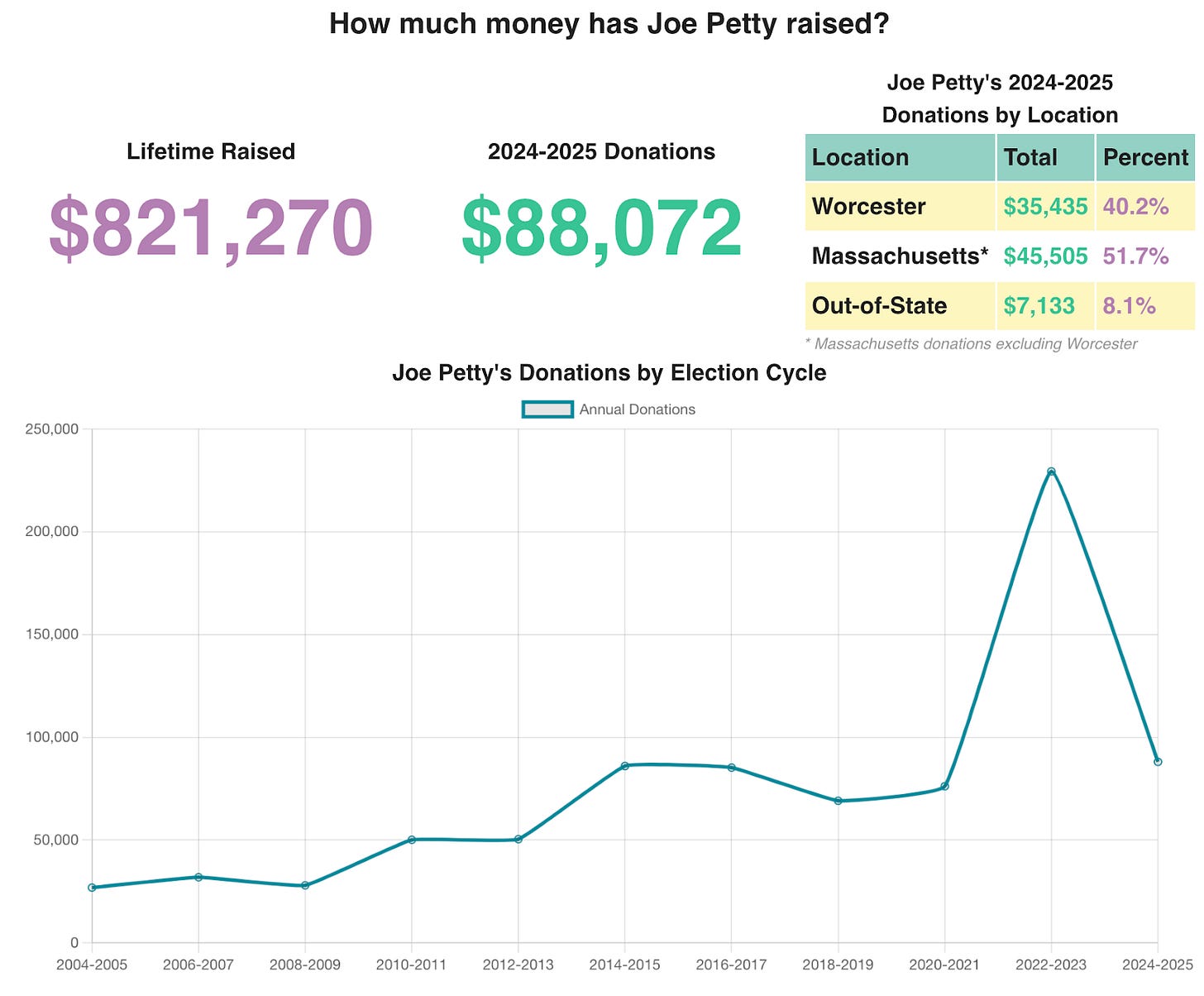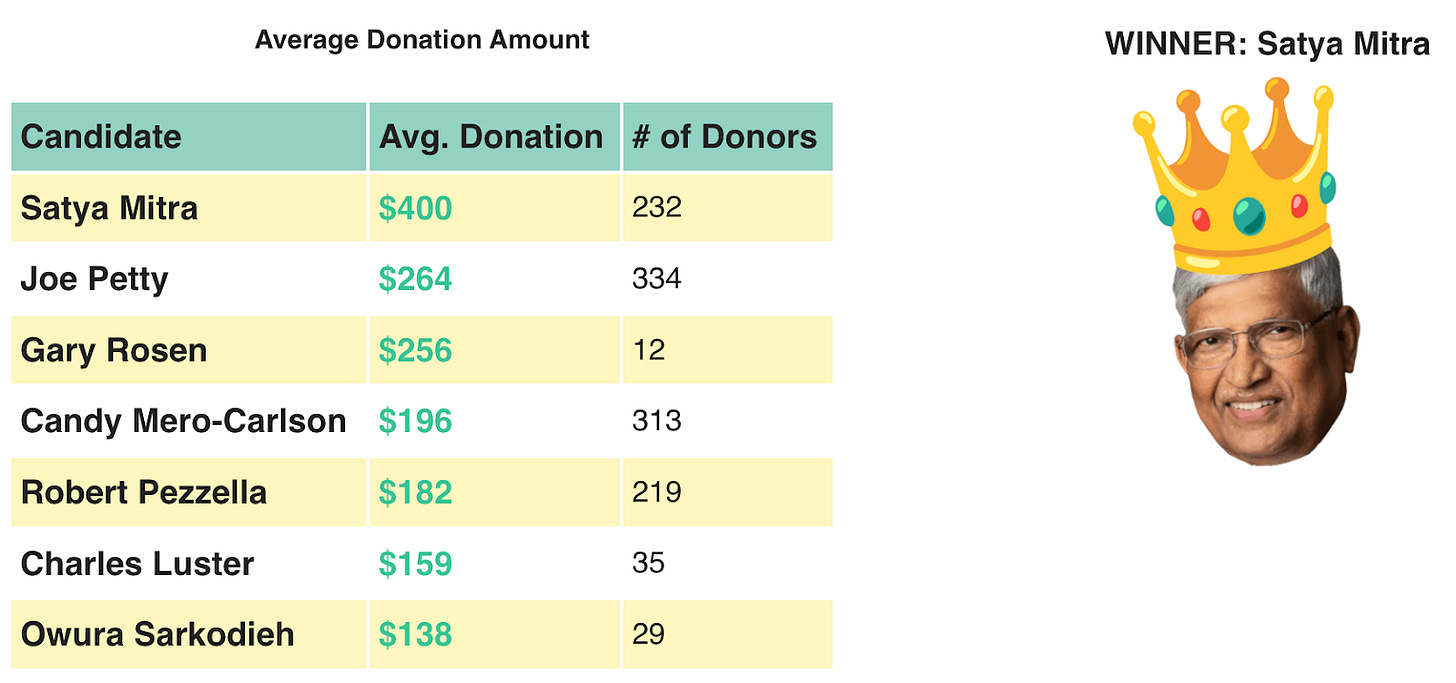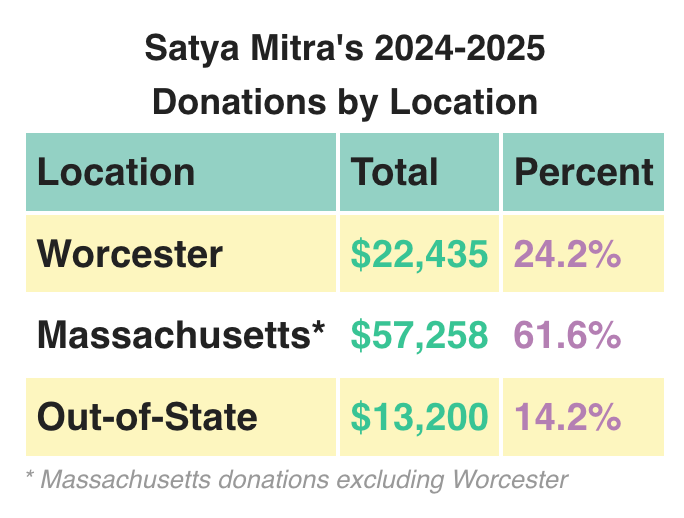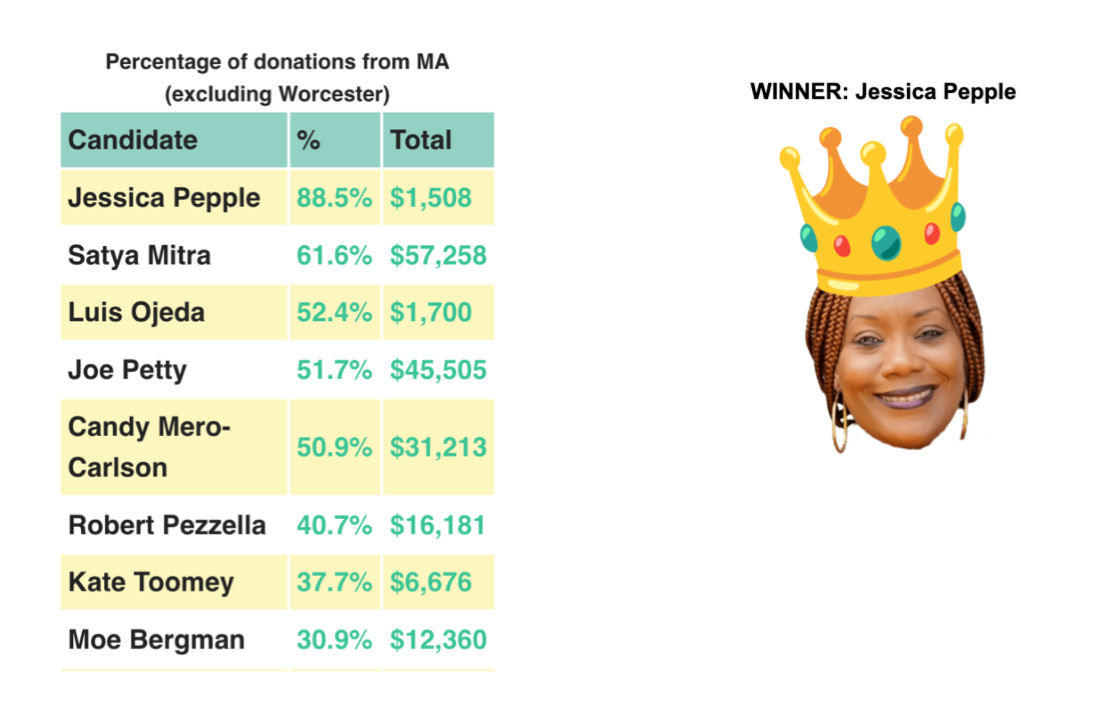Introducing: WorcesterElection.com
Ahead of the preliminary, we break down all the campaign finance data and put it back together
Hey folks, Greg here. I’m taking over for Bill this week as the lead-in writer. This project is a first-of-it’s kind for Worcester Sucks, and Worcester politics as a whole. While campaign finance data is openly published, no other publication has done deep analysis on where the money comes from and how it influences our local politicians. In part one, we’ve done a broad analysis of donation trends for each candidate: how much money they’ve raised, where it comes from. In part two, we’re going to take a deeper dive to put faces to the names of the major donors for each candidate.
We’re going to aggregate data from a variety of sources to show you who’s paying for each candidate—and what they get out of it.
This project is so much more than a couple of newsletter articles. We’ve created a website, WorcesterElection.com, where you can find all the data used in this article, plus information about each candidate’s history and policy positions. There’s a subpage for each candidate, which looks like this:

The website will be updated as we work on part two, going into the election. As Tom Marino recently pointed out in This Week In Worcester, most candidates barely put any effort into articulating substantive policy positions. Some candidates don’t have websites. Moe Bergman let his website registration lapse, and only got it back about a week ago (I know because I looked into buying it from GoDaddy).
Here’s my first ask: read this article, or don’t, but check out WorcesterElection.com for a detailed breakdown of the campaign finance data we have. We all have the opportunity to do something amazing here. As I said before, the online presence of our elected officials and the most powerful people in our city is largely a joke. It would be relatively easy to outdo them in search engine optimization to make sure our coverage is included in top search results and AI summaries when you look up each candidate. To do that, I need your help: If you have a website or blog, link WorcesterElection.com. Share WorcesterElection.com on your social media. When you put your phone down before bed, lean into the microphone and whisper “WorcesterElection.com” (just kidding, they only listen to you for ads). Google ranks things partially based on how many people link to it. With your help, we can get the site to the top before the general election.
This work is the product of dozens, if not over a hundred hours of labor, and over 30,000 lines of code (so far). If you want to support more work like this, do me one more favor: subscribe (duh) and send me a tip via venmo. I recently got laid off, and could use the help. This website is going to be my job for a couple of months.
Who’s Running, and Who’s Paying?
We follow the campaign finance trail to find out
By Gillian Ganesan and Greg Opperman
Hey! Gillian here. Why scrutinize municipal election campaign finance data? Partly because on principle, someone should. National and state races naturally face more scrutiny, and we can thank the hard work of countless watchdog organizations for diligently tracking federal elected officials. But those organizations don’t have the capacity to also catalog, analyze, and maintain municipal campaign finance reports—there’s just too many places the data is stored, too many slightly different provincial rules and processes. And with the collapse of local journalism, there’s no one to fill in the gap. Just more collateral damage of the great Gannett Media smash-and-grab of every local outlet.
We should be scrutinizing municipal campaign finance because municipalities are where policy rubber meets the road (we’re the road). It’s local elections where money has the most direct impact on day-to-day quality of life. For instance, the issue of homelessness in Worcester is the direct result of malicious negligence on the part of our city council. They routinely fail to do anything for a reason; it’s active austerity politics. The less money they provide for the actual services people need, the more money they have to hand out tax breaks. This is why developers and other special interests care about these races; if they pay to get someone elected they can expect a return on their investment. If they don’t get it, they’ll fund someone else next time. A few thousand dollars in campaign contributions can multiply into millions of dollars of tax savings and preferential treatment.
We have been working on building out WorcesterElection.com to track our local candidates’ war chests. In this post, we’ll give you some of the toplines, as we continue scrutinizing this data and laying out each candidate’s policy priorities. This Tuesday's preliminary election, we narrow the at-large council race by two—we’re likely going to see even more interesting data once the field for the general is solidified.
Ok, take it away Greg!
Which candidate has raised the most money?

The biggest, and most talked about, surprise this election cycle has been the incredible amount of money raised by first-time candidate Satya Mitra, seemingly out of nowhere. Mitra has raised an eye-popping $92,893 from 232 donors so far, which already breaks the record for most money ever raised for a Worcester city council candidate, outside of Joe Petty’s combined run for mayor and state senate last election. For contrast, Joe Petty’s most expensive mayoral campaigns were in 2015 and 2017, where he collected around $85,000 each cycle. Khrystian King netted $59,827 in the 2022-2023 election cycle; many incumbents benefitted from a surge in donations, possibly due to the state special election. So where does the money come from?
The vast majority of Mitra’s donations come from outside the city. Out of $92,893 raised in total, $70,458 has come from donors out-of-town or out-of-state entirely. When asked about these donations, Mitra said, “Many of these donors, though not residents, have a vested interest in Worcester — through investment properties, business activities, or family ties.”
Oh my God, he admit it: Satya’s biggest supporters are out-of-town investors who want to mine Worcester for profit.
There’s Mitra, then there’s everybody else
Looking at the rest of the candidates, some interesting narratives unfold. Alleged bigot and D2 Councilor Candy Mero-Carlson has raised $61,278, over 50 percent more than the next district candidate. With more than two months left in the race, Mero-Carlson has almost topped her fundraising record of $70,356 from last election cycle.
Progressive challengers have put up impressive fundraising numbers this year. In total dollars raised, LGBTQ+ activist Cayden Davis ($11,983) is neck-and-neck on fundraising with conservative incumbent Donna Colorio ($11,627), which may foreshadow an upset victory in the At-Large Council race. Etel Haxhiaj (D5) has continued to out-raise challenger Jose Rivera, thanks in part to a surge in donations after she stood against an ICE raid on Eureka street.
Luis Ojeda (D4) is the cheapest date of all the incumbent city councilors, having won his seat last election with just $8,075 in donations. This year so far, he’s raised $3,245 from 25 donors, while his opponent, Ted Kostas, has raised $6,269.
Which candidate’s donors have the deepest pockets?

No surprises here, Satya Mitra has been collecting a healthy average of $400 from each of his 232 donors. Mitra has the highest number of donors of any candidate who have maxed out to the donation limit of $1,000. Mitra’s average donation is almost double the next candidate, Joe Petty, who collects $264 on average per donation. In line with national trends, progressive and liberal candidates raise most of their money through smaller donations. Cayden Davis and Etel Haxhiaj both win the Bernie Sanders Award for small donations, sharing an average donation amount of $53 (the state minimum for reportable donations is $50). At-Large Incumbent and Mayoral candidate Khrystian King averages $84 per donation, from 333 donors, the most small donations of any At-Large councilor.
It’s notable how many candidates are propped up by fewer than 40 donors. Gary Rosen is funded by a dozen friends and family, including himself. Other small-donor candidates include Charles Luster (35), Owura Sarkodieh (29), Luis Ojeda (27), Jessica Pepple (21), and Edson Montero (8).
It’s also notable that 192 people have been willing to give $19,379 to disgraced former State Senator John Fresolo, despite allegations of domestic violence, sexual harassment, and ethics violations (we’ll talk about who those donors are in part two).
Where do the candidate’s donors come from?
Townie’s Choice: Who has the highest percentage of donations from Worcester?
WINNER: Owura Sarkodieh
Sorry, Edson Montero, we’re giving it to Owura Sarkodieh. Besides Montero, who has only raised $515, Owura Sarkodieh has raised the vast majority (82.4 percent) of his money from inside Worcester city limits. Of candidates that have raised over $10,000, D2 candidate Rob Bilotta tops the list at 76.8 percent, followed by Jose Rivera (76.6 percent), and Tony Economou (73.3 percent). While Joe Petty ($35,435) and Moe Bergman ($27,399) have raised the most from within Worcester, Rob Bilotta has the distinction of raising the most total of all candidates with higher than 70% of their donations coming from within Worcester (and the most of any district candidate).
Seven candidates collect fewer than 50 percent of their donations from Worcester residents: Jessica Pepple, Satya Mitra, Joe Petty, Candy Mero-Carlson, Robert Pezzella, Luis Ojeda, and Charles Luster.
Suburban Influence: Who has the highest percentage of donations from Massachusetts, excluding Worcester?
WINNER: Jessica Pepple
Jessica Pepple is the suburban people’s princess, raising almost all of her money (88.5 percent) from outside of Worcester, mostly from co-workers at RFK Community Alliance. However, these donations are dwarfed by second-place finisher Satya Mitra, who has raised $57,258 from surrounding areas in Massachusetts. Rounding out the top 3 for candidates who have raised over $10,000, Joe Petty (51.7 percent) and Candy Mero-Carlson (50.9 percent) have filled just over half of their campaign war chests from in-state donations from the suburbs and elsewhere in Massachusetts.
Outsider Influence: Who has the highest percentage of out-of-state donations?
WINNER: Gary Rosen
Gary Rosen has the largest percentage of out-of-state donations, mostly thanks to support from a family member in Boynton Beach, Florida. Cayden Davis is runner up, with $2,165 out of a total $11,983 raised from outside Massachusetts. In terms of total dollars raised, Satya Mitra is still the king of outside influence, having taken a whopping $13,200 from out-of-state donors with aforementioned business interests in Worcester. Joe Petty and Robert Pezzella get honorable mentions for raising $7,133 and $4,400 in “outside” money, respectively.
Seven candidates have the distinction of taking no out-of-state money: Luis Ojeda, Jose Rivera, Jessica Pepple, Edson Montero, Donna Colorio, Charles Luster, and John Fresolo (although you do not, under any circumstances, have to hand it to him).
Back to Gillian to close us out.
The stakes have never been higher
The cost of running a local campaign is anywhere from a few thousand dollars to upwards of a hundred thousand, depending on the candidate. Most of the genuine competitors in the race for city council have raised at least ten thousand; some of them, as you’ve seen, have raised way more. When we get closer to the general election, we’ll find out how much money (and illegal yard sign placement) talks when it comes to actual votes, especially for first-time candidates like Satya Mitra. However, the eyebrow-raising numbers that candidates like Mitra and Petty are putting on the board this election are dwarfed by the financial stakes for the people paying for them. Millions of dollars in tax breaks and business deals are on the table right now. Burning through a few thousand at the top could pay off immensely.
Like Bill talked about in his preliminary election guide (which you should read again before Tuesday!), if you weren’t on Mitra’s Top of the Tower invite list with the developers, healthcare big dogs, and Candy Mero-Carlson, you’re probably not who the political elite in this city plan to represent. These are the power players, and they know the stakes.
For a long time, Worcester’s financiers have gone unscrutinized, but these interest groups are represented by real people whose names are in these campaign filings. It’s time they get called out for who they are and what they’re doing to the people who live in this city.
As election season continues, we’ll update WorcesterElection.com with more information on each candidate, their backgrounds, their donors, and more. So stay tuned for Part Two, where we’ll take a deeper dive into Worcester’s power donors and which politicians are in their pocket.
Bill here with a quick note from the editor to say Gillian and Greg have done tremendous work here and I’d very much like to pay them handsomely for it. It was a real treat to watch and lightly guide this project to development. Greg and Gillian both took to the data analysis work with gusto, doing a lot of back end preparation. And then Greg did his wizardly coding things I can’t even begin to understand to build out that website. Really, really proud to be putting this up today.
So—hat in hand—I’m humbly asking for contributions from you, my dear readers, so we can do more of this stuff! Best way is a paid subscription of course.
Second best way is placing a nice chunk of change in the tip jar! This is a relatively new feature, hosted on BuyMeACoffee which is a nice tool well used by writers all over, and it includes a monthly or yearly contribution feature (ideal for subscribers who’d like to be giving more than $5 a month.)
It’s not as good as cash in hand, but each of you has the power right now to be our advertising representative. The only form we have is word of mouth, and on the strength of the work and the enthusiasm of the community, it’s worked out so far. So repping this work to your friends and family and strangers on the internet via social media helps us expand our dominion of influence… how The Spider builds its Web of Spies!!
Also: this project started as a conversation at the first Election Squad bar night, making it the only proof we need those events are worth the time and effort they take to put them on. (Next one is tentatively Sept. 13, Steel & Wire, more info real soon!)
Now to soaking up the sun. Happy Labor Day everyone!!










If Charles Norton from both Chestnut Hill and Dover is the illustrious and recently become infamous "Chip" Norton he found a way to come up with $11,650 for the election while ducking more worthy creditors. Petty got $6,450, Mero-Carlson got $3,750 and poor Kate Toomey came in a distant third with $1,450. Maybe these three - (3) can refund these donations into a gofundme for his creditors or directly into assumed property tax arrears.
Although I'm not in District 5, Tim Murray's $600 to the Rivera campaign is a gut punch to anyone who admires his opponent as much as I do.
Vote for change! The outcome of the election can be based on the turnout of folks that cannot afford to donate to candidates!
This was interesting enough that I paid for a subscription in order to comment. I like what you're doing here. You're not actually the first - I have been doing this for twenty years now, and for a while my students were doing annual projects on this, with the cooperation of some of the council members and candidates.. See here for details:
https://wordpress.clarku.edu/rboatright/worcester-campaign-finance/
I don't make data available during the election because (a) I don't want to be accused of helping or hurting any candidates, and (b) it is hard to get a sense of fundraising during the campaign, especially before the preliminary. But I think what you are doing serves a useful function in informing voters during the election campaign, which I haven't done.
A couple of constructive comments on how to make this better, though: First, it is misleading to use percentages of receipts to describe candidates' fundraising base, as you do here. True, Gary Rosen has received a large percentage of his funds from out-of-state donors, but come on, the guy barely raises any money. Same goes for the other people you've listed at the top. All of them have raised pretty tiny amounts of money. List them by amounts instead.
Second, the individual donation cap in Massachusetts is sufficiently low that you can't really learn much about candidates by seeing who their largest individual donors are. By the end of the campaign, many new candidates will have raised a lot of $1,000 donations, and the incumbents will have raised $2,000 from many people just because they have been raising money for longer. You're going to have to make choices about which $1,000 or $2,000 donors you list, and those decisions will likely be arbitrary. Or your list will just be too long to be all that useful for the more competitive candidates!
Instead, what I would recommend is (a) pay attention to which PACs are giving. Those are easy to track. Those also give you a better sense of what candidates' priorities are; (b) figure out how much overlap there is among candidates' donors - that tells you far more about their politics than who some of their top donors are; and (c) see how much of the money you are looking at here is self-funding.
It is also really important to download the independent expenditure (e.g. Super PAC) disclosures. There won't be that many of them, but they can be pretty consequential.
I'm happy to talk with you about this sometime if you want.